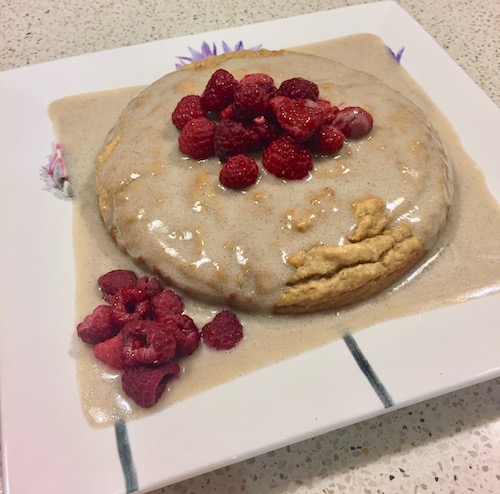Simple Swaps
Next time your gluten, dairy or sugar-free friend pops around for a meal, forget the fuss and try these simple ingredient-swaps.

With food allergies and intolerances increasingly common, catering to friends and family with stringent requirements can seem daunting. But hosting them needn’t be a hassle. We are lucky to live at a time with so many replacement products on our shelves.
Common food issues
Common allergies and intolerances include wheat, dairy, eggs and nuts. Other foods such as seafood, legumes and some fruits and vegetables such as citrus can also be triggers for people. Add to this that many people are cutting out sugar from their diet. Your guests are likely to be the expert on their needs and can tell you what they can and can’t have. Knowing how and what to substitute, and being prepared to experiment a little, can really help.
My top 7 ingredient-swap ideas
I love to bake and cook, and I often substitute common ingredients. Here are seven ingredient alternatives I often use.
- Wheat flour for other flours. You can swap wheat flour for gluten free, rice or quinoa flours in cakes and batters. Gluten free flours will give a slightly different texture to a gluten-based flour. It will often be a little more dense but there are tricks for mimicking wheat flour. Here’s a recipe for fluffy gluten-free scones! If using coconut flour as a substitute for wheat flour, only use ½ the quantity of flour in the recipe.
- Butter for non-dairy butter, olive oil or coconut oil. Butter is often a binding agent, so substituting it for another fat generally works. It works for me with cakes, batters and scones. I have also read that olive oil can be used in pastry. Butters such as Nuttelex work well in sandwiches, fresh or toasted!
- Cows milk for soy, almond, rice or oat milk. When it comes to baking, this is pretty much a like-for-like swap. These milk options also taste great on cereal and in hot drinks. It is handy to have one of them in the fridge when that dairy-free cousin pops around for a cuppa.
- Cream with coconut cream. Keep in mind, coconut cream does have its own flavour, which will infuse into the recipe that you are cooking. It can be whipped like dairy cream.
- Sugar for rice malt syrup, honey or maple syrup. Only use half the quantity of the sugar in the recipe if substituting with honey or maple syrup, or 1:1 for rice malt syrup. You will also need to adjust the dry ingredients slightly (usually only 2-3 tablespoons for each cup of liquid sweetener). Alternatively, leave the sugar out entirely - especially if there is fruit in the recipe. Here is a thorough rundown on baking with sugar alternatives.
- Eggs with flax or chia eggs. This only works where whole eggs are used and they are not the primary raising agent. To make 1 chia or flax egg, mix 1 tbsp chia or flaxseed meal with 3 tablespoons of water, and rest for 10 minutes. Stir well before adding to your mix. Chia eggs add a little crunch and flax eggs add more fibre.
- Eggs with aqua-faba. Aqua-faba is the liquid drained from a tin of chickpeas! Instead of throwing it away it can be used instead of eggs. It even whips up well as a replacement for whipped egg whites.
Once you get the hang of swapping ingredients , you can even experiment with traditional decadent recipes to produce what in my opinion is a tastier, healthier option! Here’s a bonus gluten, egg, refined-sugar and dairy-free Ginger Sandwich recipe that I created based on this SBS Food recipe.
Gluten, egg, refined-sugar and dairy-free Ginger Cake
Ingredients
- 25 g. non-dairy butter
- 100 g. Rice malt syrup/honey/maple syrup
- 2 tbsp. Chia seeds + 6 tbspn water
- 125 ml rice/soy alternative
- ½ tsp baking powder
- ¾ tsp bicarbonate of soda
- 175 g gluten free self raising flour
- 3 tsp ground ginger
Method
- Mix chia seeds and water together in a small bowl. Let sit while you gather the other ingredients.
- Turn the oven on to 180C. Grease and line an 18cm round cake tin.
- Mix butter and rice malt syrup together until light.
- Add the chia seeds and water mixture and mix through.
- In a separate bowl, mix the flour, bicarbonate of soda and ginger together.
- Add half the dry ingredients and milk, mix to combine then add the rest.
- Ensure it’s all mixed through well.
- Pour into the tin. Bake for 25min or until a skewer poked in comes out clean.
- Cool on a wire rack.
Caramel Topping
Ingredients
- 1 tin coconut cream
- 2 tsp vanilla
- pinch salt
Method
- Put all ingredients in a saucepan and simmer over a low heat, stirring regularly until reduced and browning in colour. Remove from the heat and store in the fridge until ready to use.
- If the caramel is too thick to spread it can be gently heated to a spreadable consistency.
With a bit of knowledge, tweaking your favourite recipes for food-intolerant or allergic friends needn’t be a fuss. In fact, it may even add some new flavours and recipes to your repertoire while making them more healthy!